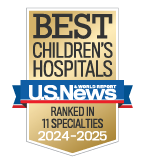Trisomy 13
What is trisomy 13?
Trisomy 13 is a condition caused by an extra copy of chromosome 13. Chromosomes provide the genetic instructions that program the body to form, grow and develop. Having an extra copy of chromosome 13 causes the body to form differently.
What are the challenges with trisomy 13?
The most common differences seen in individuals with trisomy 13 are brain anomalies, eye anomalies, cleft lip, cleft palate, kidney anomalies, extra fingers and/or toes, and abdominal wall defects such as omphalocele. In addition to physical differences, the body also works differently. Breathing problems, feeding difficulties and developmental disabilities are common. Most babies with trisomy 13 are not able to overcome the challenges and pass away in the first few weeks of life.
What causes trisomy 13?
Trisomy 13 is caused by and extra chromosome 13 being present in either the egg or sperm that made the baby. This condition occurs sporadically, meaning parents cannot cause it to happen. Trisomy 13 does not typically run in families. Occasionally, one parent may have a chromosome rearrangement that increases the chance of having children with chromosome differences. It is important that a chromosome analysis be completed to ensure accurate recurrence risk information is shared with the family.
How common is trisomy 13?
Trisomy 13 is seen in approximately 1 in 10,000-25,000 live-born infants.
How is trisomy 13 diagnosed?
Trisomy 13 is diagnosed by a chromosome analysis, also called a karyotype. This test can be done during the pregnancy or after birth. During the pregnancy an amniocentesis procedure removes some fluid from the sac surrounding the baby. A chromosome analysis can be completed on the fluid. After birth, a small blood sample is obtained from the baby for a chromosome analysis. It takes two weeks to get results from a chromosome analysis. Often a preliminary test called FISH can be completed in two days for a rapid result.
There is a blood test available during pregnancy that screens for trisomy 13. This screen helps determine if the fetus has a high chance or low chance of having trisomy 13. The blood test during pregnancy does not diagnosis trisomy 13.

Want a second opinion?
If you’ve recently received a diagnosis or would like a second opinion, experience matters. We're happy to share our expertise with you. Call (816) 855-1800 to make an appointment with our team.
What is the treatment for trisomy 13?
There is not a cure for trisomy 13. Treatment is focused on the individual’s medical needs. Most babies with trisomy 13 die in the first few days or weeks of life, even with invasive medical interventions. The health care team and the family should work together to establish goals for the child and ensure that the medical interventions are working towards the goal.
Who is on the care team?
At Children’s Mercy Hospital, we have a large care team for children who have trisomy 13. Our Fetal Health Center provides comprehensive care for families expecting a baby with trisomy 13. Our multidisciplinary team works with families to prepare for the birth of the child. Our goal is to provide multiple layers of support to ensure that each family has the best possible experience. Below is a list of teams most commonly involved in the care of children with trisomy 13.
- Maternal Fetal Medicine Specialists, high risk OB doctor
- Ultrasonographers
- Genetic Counselor
- Palliative Care team
- Neonatology
- Cardiology
- Surgeon
- Social Workers
- Child Life Specialists
- Chaplains
